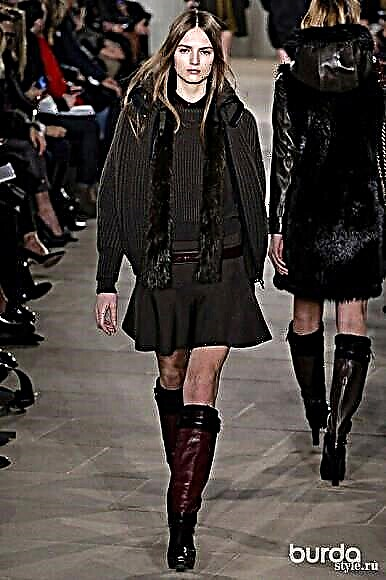Do not save on sleeves! A straight, slightly loose dress of laconic cut from a discreet, calm shade of fabric holds its trump card in the sleeve ...

It is easy to give a bright accent to any dress of a simple cut with the help of trendy voluminous sleeves-puffs made of light, airy fabric. Moreover, in such a simple way, you can create a daring mini-dress in the style of the 80s for bright New Year's parties or a gentle and cozy outfit for Christmas gatherings in the circle of relatives and friends.
Depending on the color and the fabric chosen - tulle, organza, chiffon - the sleeves can turn out to be shocking and trendy or, conversely, airy and watercolor.
In this master class, we will show a quick and easy way, without complicated modeling, drawings and calculations, how to make voluminous sleeves-puffs on the basis of a dress pattern with a usual set-in sleeve.
You can take any of the proposed Burda patterns as a basis:
- Special offer

- 1
- 2
- 3
- 4
- Special offer

- 1
- 2
- 3
- 4
- Special offer

- 1
- 2
- 3
- 4
- Best-seller
- Special offer

- 1
- 2
- 3
- 4
You will need:

- a piece of fabric from which puff sleeves will be made: soft or medium hard mesh, euro-tulle, organza. The mesh consumption in this workshop was 1 m with a mesh width of 3 m (or 2 m with a mesh width of 1.5 m);
- tailor pins;
- chalk or washable marker for tissue;
- measuring tape;
- The pattern is “saber” (you can do without it);
- scissors, threads, needle.
DIY removable mesh skirt
Step 1. Modeling puff hoses

By the time the puff hoses are made of mesh, it is necessary to prepare the part of the set-in sleeve from the main fabric. In addition, it is already possible to prepare the dress for the stitching of the sleeves: perform side and shoulder seams, process the neck and bottom.

For one sleeve, prepare a part measuring 150 * 50 cm in two layers. So that the layers do not move relative to each other, chop them along the sections with the help of tailor pins; further work with them as with one detail.
Mesh sleeves can also be made in more layers, then they will be more voluminous and "dense".

Fold the part in half in width so that you get 4 layers of mesh with a height of 50 cm and a width of 75 cm.

Fold in the set-in sleeve from the main fabric in half and measure its longest part along the fold.
In my case, the length in the center of the sleeve is 40 cm, taking into account allowances.

By the bend (center of the part) of the grid we measure 40 cm + 6 cm = 46 cm.
These 6 cm are needed for lapping, due to which the volume of the buffer will be formed.

At a height of 46 cm, mark with a tailor's chalk or a washable marker.

Now we measure the shortest part of the sleeve - at the elbow sections.
In cuts, the length of my sleeve is 29 cm, including allowances.

By sections of the grid we measure 29 cm + 6 cm = 35 cm.

In a similar way, we will find an intermediate mark: we measure the length of the sleeve in the middle of the folded part.
The length of my sleeve in the Quaternary is 35 cm.

Find the center of the part from the grid and measure 35 cm + 6 cm = 41 cm in the center.


We got 3 tags, which now need to be connected using the saber pattern.

Cut the part along the line.

The result was a symmetrical sleeve detail with a width of 150 cm with a smooth curved armhole line.
Despite the fact that the armhole of the set-in sleeve from the main fabric is asymmetric and its line has a complex curved path, the symmetrical shape of the mesh buffer is permissible in this case - a large volume of the buffer allows such a “conditional” cut.
To ensure that the layers of the mesh part do not move relative to each other, chop them with tailor pins. And also leave pins-tags indicating the middle of the part above and below (or mark the middle with a marker).
Marine watercolor: "exciting" decor with soft mesh braid
Step 2. Formation of the puff

Now you need to pick up the sleeve. To do this, lay the pick-up stitch along the bottom and along the line of the line at a distance of 1 cm from the sections with a minimum thread tension and with a stitch length of approx. 5-7 mm.
How to pick up fabric

Leave the ends of the threads free and not short.

Labels that indicate the middle of the part do not need to be deleted yet.

Combine the midpoints of the set-in sleeves from the main fabric and the sleeves from the mesh above and below, chop. The mesh part will fall with a small influx.

In two steps, pick up the part from the mesh along the line of okat, pulling the lower thread. First, on one side of the middle mark. The ends of the threads tightly knit and do not cut short.

Then, in a similar way, pick up the part on the other side of the middle mark of the part. Thus, we equalized the details of the sleeve along the line of okat.

Also pick up a piece of mesh on the bottom of the sleeve: first, on one side of the mark marking the middle of the bottom of the sleeve, and then on the other side. The ends of the threads tightly knit and do not cut short.

Here is what happened at this stage.

Now it is necessary to complete the elbow sutures of both parts of the sleeve. To do this, chop the part from the mesh from the main part of the sleeve and chop the elbow sections of each part.

Run elbow sutures. I sewed the seam of the sleeve from the main fabric using an overlock, and the seam of the sleeve from the mesh on the machine.

The seam of the puff sleeve can also be processed using an overlock or double seam. But I just made a straight line with a short stitch length and cut the allowance to a width of ~ 3 mm.

Now you need to turn out the sleeves on the front side and again chop them along the line of okat and on the bottom. First, combine in the seam area and the middle of the parts by inserting a sleeve from the main fabric inside the sleeve-puff.

And then chop the assembled sections of the sleeve-puff along the entire line of okat and along the bottom line on the sleeve, evenly distributing the assembly of the sleeve-puff. You can notice.

Connect the sleeves along the line of okat and on the bottom, laying a line just below the sewing line. The sewing threads can be removed.

The puff sleeve is ready.
Blooming garden: do-it-yourself fantasy volumetric decor
Step 3. Processing the cuff

Prepare the cuff part. My cuff is a little narrower than the sleeve itself, its dimensions are 26 * 6 cm (finished width 2 cm).

Duplicate the cuff.

And grind short slices. Cut off corners of allowances, iron allowances.

Press the cuff in half.



Unfold the cuff again and overcast one of the sections with an overlock (you can process it with an oblique trim.


Chip together the bottom of the sleeve and the raw cut of the cuff, connecting them first in the seam area, and then around the entire circumference, laying the bottom of the sleeve in small folds.

Lay the stitch exactly in the seam connecting the main sleeve and the puff sleeve (or just below this stitch), i.e., the allowance is 1 cm.

In order to slightly reduce the plumpness of the allowance, you can lay another line along it, it will press down the allowance, make it flatter.

Tighten the free, knitted section of the cuff to the inside, forming the cuff of the desired width - 2 cm.


Secure cuff stock with tailor pins or sweep.

Stitch the cuff allowance by sewing a stitch from the right side exactly in the seam of the cuff stitching, stitch length ~ 3.5 mm.

The cuff is ready.

It was possible to make the cuff in the usual way, fixing all the layers with the overlay (if you are knitting) or hemming the allowance manually (if you are working with fabric). But in this case, the allowance for the bottom of the sleeve is very puffy, and when processed in a different way, it would inevitably puff up and cause discomfort to the hand. With the described processing method, the cuff allowance lies flat, and the volumetric allowance for the bottom of the sleeve is hidden inside the cuff.
Flower range: a secret decor in a romantic style
Step 4. Sew in the sleeve

The sleeve is almost ready. It remains only to embed it in the armhole in the usual way.
How to sew different types of sleeves
Insert the sleeve into the armhole, aligning the side and elbow seams, as well as all the marks.

Stitch the sleeve into the armhole, laying the stitch exactly in the stitching line or a little lower.

Overlock the overlock using overlock. To iron an allowance on a shelf and on a back.

The sleeve is ready.
Using the modeling principle described in Step 1, a transparent sleeve can also be made. In this case, the cut-out sleeve from the net just needs to be picked up and stitched into the armhole of the product.


So different images can be created with the help of such sleeves on the basis of the same pattern.
Happy New Year and wish you new sewing victories!
The author of the master class and photo: Daria Tabatchikova

By education, Daria is a PR specialist and economist, but several years ago she devoted herself entirely to her favorite business - sewing.
She studied sewing from magazines, books and using the Internet, there are also sewing courses in the arsenal, but Daria considers herself self-taught. She loves to study specialized sewing literature from different years and countries, and then put her knowledge into practice.
At the end of 2017, Daria became the winner of the festive contest from BurdaStyle.ru.
She leads her Instagram page and VKontakte group.
Material prepared by Julia Dekanova



